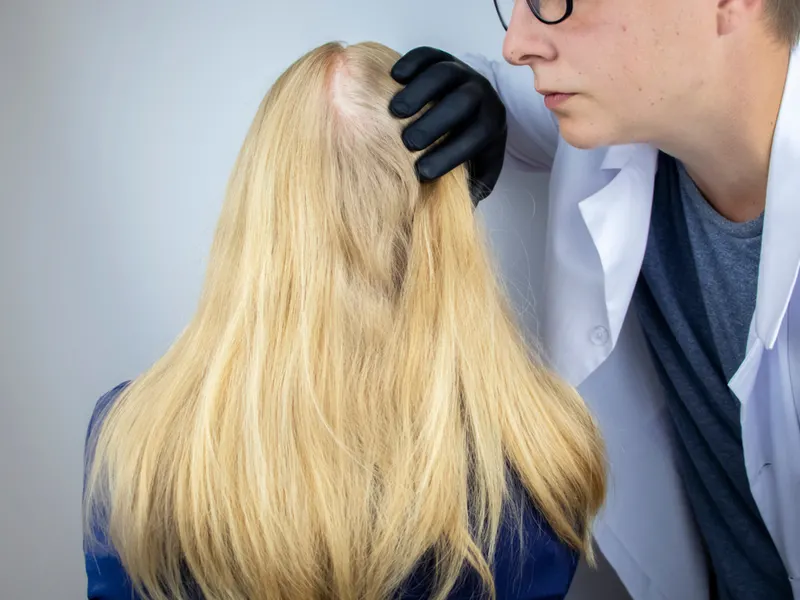Jump to:
Everyone’s heard of someone who burned their scalp in a chemical hair process gone wrong, but knowing how to treat chemical burn on scalp can save you from becoming one of those horror stories.
Whether you’re experiencing a DIY disaster or repairing your stylist’s mixing mistake, this article will give you all the information you need to treat a burned scalp at home.
Treating Chemical Burns on a Scalp: A Summary

Alona Siniehina/Shutterstock
If you have a chemical burn on your scalp, you must act quickly to prevent any further damage from occurring. This article will explain the process of treating a chemical burn on your scalp in detail. The process is a lot like any first aid treatment, with four basic steps:
- Rinse the scalp thoroughly
- Dress the wound
- Let it heal
- Seek medical attention
With prompt treatment and plenty of aftercare, you can treat and heal a chemical burn at home, saving your scalp and your hair. Keep reading to learn more about the best home remedy for a chemical burn on your scalp.
How to Treat Chemical Burn on Your Scalp in 4 Steps
Many people have skin sensitivities or allergies to the chemicals in common hair processes such as coloring, perming, bleaching, and relaxing.
That’s why most at-home chemical processes recommend that users do a patch test 24 hours in advance of the process to identify any potential allergies or sensitivities. However, some chemical processes can cause scalp irritation and burns, even in people with no known sensitivities.
Burns can be caused by improper mixing of the chemicals, which can cause them to react more intensely than expected, or by a reaction to other chemicals that are already on your hair, especially if you’re doing more than one chemical process at a time.
Sometimes there’s no discernible reason, other than bad luck, but chemical burns can happen anyway. When it comes to treating a chemical burn on your scalp, it doesn’t matter what caused it or who’s at fault.
The important thing is acting quickly to save your skin and hair. Chemical burns are extremely painful and can even cause long-term issues with your skin and hair if not treated properly.
Severe burns require prompt medical attention, but most chemical scalp burns can be treated and healed at home. You probably have everything you need to treat it on hand already, which will help you act fast.
1. Rinse the Scalp Thoroughly
The first step to treating any chemical burn is preventing any additional damage by removing the product that’s causing the burn. Any chemical that remains on your skin will continue to burn until removed, so you must get every last bit off.
This is particularly difficult on the scalp, as the product can get stuck to your hair, so thorough rinsing is essential. Wear gloves to keep the skin on your hands from being exposed to the chemical on your scalp.
Rinse your hair and scalp thoroughly under cool running water to get all the chemicals off your skin and hair. Avoid warm or hot water, as heat can increase the intensity of the chemical reaction, causing further burns.
Try to rinse in the shower so your hair can hang and the water can flow freely rather than pooling at the bottom of a sink.
Keep rinsing for at least 10 minutes to ensure you’ve rinsed out any remaining chemicals. Gently squeeze excess water out of your hair with a clean t-shirt or soft towel, being careful not to pull or rub the scalp. Gently blot the burned area dry.
2. Dress the Wound
Once you’ve removed the offending chemical from your skin and dried the damaged area, you need to protect it from further damage.
You’ll want to use a combination of a natural or medicated anti-inflammatory and pain reducer, followed by a protective ointment and bandage, if necessary. First, apply a wound care salve, burn cream, or antibacterial ointment to the burned area using a cotton swab.
There’s a wide range of natural and medicated options to choose from, but the most important thing is to keep the burn site clean and moisturized for maximum healing. Some moisturizing ingredients offer more relief than others, though.
Aloe vera, for example, is a natural, plant-based gel taken from the aloe vera plant. It’s a natural anti-inflammatory and pain reliever that provides a cooling sensation to ease discomfort. Coconut oil is another good choice because it’s moisturizing and naturally antibacterial.
It’s as good for your hair as it is for your skin, so it may also help repair any hair that was burned. Other natural burn treatment options you may already have in your home include:
- Milk. Milk is full of natural proteins and fats that can provide soothing, moisturizing relief to burned skin.
- Apple Cider Vinegar. Dilute ACV with an equal measure of cool water and gently blot it on the burned area to minimize blistering, kill bacteria, and relieve pain. Rinse after 10 minutes.
- Honey. Believe it or not, this sticky substance is naturally antiseptic, antibacterial, and anti-inflammatory, which makes it a great choice for natural burn relief. Apply it to the burn area, let it dry, and leave it until you next wash your hair.
You can also opt for a medicated option to treat your burned scalp. Consider one of these options:
- Antibiotic Ointment. Severe burns are prone to infection, and triple antibiotic ointments can do double duty by moisturizing the burned skin while preventing bacterial growth.
- Petroleum Jelly. Ordinary unmedicated petroleum jelly can hydrate and protect your burned scalp, improving healing time.
- Zinc Pyrithione. Scabbing is your body’s natural response to seal off and heal a wound, but it can interfere with new hair growth and even cause your existing hair to fall out. Zinc Pyrithione, which is commonly found in dandruff conditioners, reduces scabbing so your burn can heal and your hair can continue to grow.
For severe burns, you can apply a non-stick wound dressing over whatever cream, jelly, or ointment you use to protect the burned area. However, burns that require a bandage usually also require medical care, so talk to your doctor if your burn is severe.
3. Let It Heal
Once you’ve applied first aid to your burned scalp, it’s up to your body to do the rest of the healing. The scalp generally heals faster than other parts of the body.
But depending on the severity of the burn, healing can take days, weeks, or even months. However, there are certain things that you can do to encourage it to heal quickly and reduce scarring.
- Clean Often. Wash the burned area twice a day with cool water and mild soap to remove dirt, reduce bacterial growth, and stimulate healing
- Dry Gently. Rubbing your scalp with a towel can cause your blisters to rupture, skin to flake or scabs to dislodge, any of which will delay healing. Blot the burned area with a soft towel or t-shirt.
- Keep it Moist. Continue to apply a moisturizing ointment, such as petroleum jelly or coconut oil, to keep the burned area hydrated. This will reduce pain and speed up the healing process.
As long as you keep the burned area clean and hydrated, your body can do the rest. Just keep an eye out for any signs that the burn is worsening, such as increased pain, pus, a fever, or skin that’s warm to the touch. If you notice any of these signs that your burn is not improving…
4. Seek Medical Attention
Most scalp burns aren’t severe and should resolve on their own, but some require medical treatment to heal. Severe burns can cause numbness, hair loss, infection, and even cancer if not properly treated, so take any of your body’s warning signs seriously.
Your doctor can prescribe medications to prevent or treat infections and offer pain relief. In the most extreme cases, surgical treatment may be required.
A plastic surgeon may perform what’s called a “skin graft,” transplanting healthy tissue from somewhere else on your scalp to replace the burned tissue. This is rarely necessary, but only a doctor can tell you for sure, so seek medical attention right away if your burn isn’t getting better or starts getting worse.
Frequently Asked Questions

Vladimir Gjorgiev/Shutterstock
Now you know how to perform first aid and heal a minor chemical burn on your scalp at home, but you might still have questions about chemical burns and the healing process. Here are some questions people commonly ask about treating chemical burns on the scalp.
How long do chemical burns on the scalp take to heal?
The time it takes a chemical burn to heal depends on a lot of factors, such as how much of the chemical was on the skin, how long it remained in contact with the skin, and what kind of chemical it was. Chemical burns may take only days to heal, if they’re minor, up to weeks or months for more severe burns.
How do you heal a chemical burn quickly?
Everyone’s healing time is different, but keeping the wound clean, moisturized, and the blisters and scabs intact will speed things up. To help a chemical burn heal quickly, avoid using alcohol or hydrogen peroxide, both of which slow down the healing process, and resist the urge to scratch, pick, or peel at the healing tissue.
What does chemical burn look like?
Chemical burns vary, but in general, they look similar to a standard burn caused by heat. The first sign of a chemical burn is red and irritated skin, which may swell, blister, peel, crack, or turn black due to the burn.
Will chemical burns make hair fall out?
Some chemicals may burn the hair, causing it to break off, but minor chemical burns that affect only the skin’s surface layers generally don’t cause hair loss. More severe chemical burns can burn the hair follicles, preventing them from producing healthy new hair and leading to long-term hair loss.
Can a chemical burn get worse?
If not promptly cleaned and treated, chemical burns can potentially get worse. Any remaining chemical on the scalp can continue to burn the skin, and severe burns can lead to scarring, infection, and even skin cancer, so it’s essential to seek medical advice for burns that are severe or aren’t healing well.
So, How Do You Treat Chemical Burn on Scalps?
Coloring, processing, and otherwise chemically treating your hair is generally safe if done properly, but mixing mistakes, skin sensitivities, and just plain bad luck can cause irritation and even burns.
Most chemical burns on the scalp can be treated safely and effectively at home using ingredients you probably already have on hand.
Just remember to seek prompt medical attention for severe burns, if the pain becomes severe, or if your burn gets worse with treatment instead of better.
